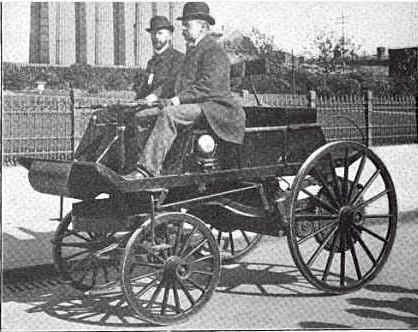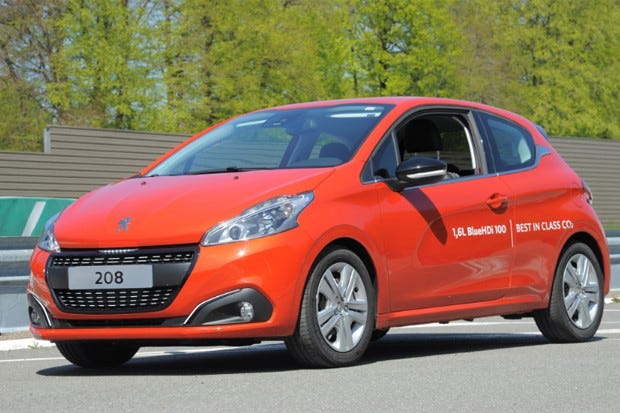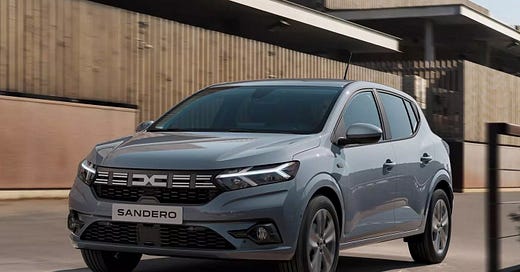Electric Vehicles: Are They Really a Solution? — Part 1
This Swedish lady would say ... "How Dare You!" But well, I think it's worth having a look at this new orthodoxy of the sacrosanct electric vehicles. Do they make sense? Are they really a solution?
Update: Part 2 of the article is now available here.
It may be challenging, but I will share some thoughts about electric cars, a topic that was brilliantly covered in a new study issued by the Manhattan Institute, titled “Electric Vehicles for Everyone? The Impossible Dream,” authored by Mark P. Mills.
The study triggered my renewed interest in the topic. I was surprised, and surprised again, by how erratic decision making seems to be taking place when it comes to public policies regarding private, passenger cars.
To this day, the challenges remain considerable, even with the much improved technologies that are currently available for EV batteries. Getting a good grasp of those challenges is critical to in turn understanding what is realistically feasible in terms of energy transition at the country and international levels.
Comprehending the challenges associated with EVs and their batteries is also critical for understanding the actual impacts of one’s individual choice for a vehicle. We are told by our governments, by most media, that EVs are environmentally friendly, that they don’t generate emissions, that they are good for the planet, for our future and that of our children.
Reality is however that producing EVs requires considerable resources and has substantial negative environmental and social impacts, often occurring in remote countries. Yep it’s a bit of a NIMBY thing - not in my backyard! These often overlooked impacts should however not be ignored if rational decisions are to be made, both at the individual and at the collective, public policy, levels.
While I initially thought I would write this article pretty rapidly, and be able to be concise, the reality is that it proved much more challenging than I initially thought.
So I will get this first part out, providing some background and general analysis. More specific points will be discussed in a second part, for publication at a later date.
Picture: The Dacia Sandero - one of the best selling cars in France and more generally in Europe. Starting price at 11 990 €, including 20% VAT, i.e. 10 000 € or 11 000 US$ before sales/vat tax. The car has a fuel efficiency of 5.2 to 5.4 liters per 100 km, which translates into some 43.5 to 45.2 miles per gallon (MPG). If current EU regulations are maintained, such cars will not be allowed to be sold in Europe by 2035. The gas tank capacity is 50 liters, which gives the car nearly 1000 kilometers of autonomy. The equivalent electric model, the Dacia Spring is available at the price of 15 800 €, which includes a 5 000 € subsidy - and further subsidies can be obtained in some instances. Normal price is 20 800 €, i.e near the double of the gas powered version. Both cars, geared towards the European market, are built outside Europe: the Spring is built in China, while the Sandero is built in Morocco. The Spring has much less attractive specifications than the Sandero. It has just a 220 km autonomy, according to the WLTP norm, i.e. about a quarter of the autonomy of the Sandero. Maximum speed is 158 km/h for the gasoline powered model and just 125 km/h for the electric model. In France, in the first semester of 2023, 12 784 Dacia Spring units were sold. In same period, 29 233 units of the (non-subsidized) Dacia Sandero were sold, according to https://www.largus.fr/
History & Context Matter
Electricity powered cars and other vehicles are very far from being new. The first electric vehicle - it was kind of a carriage - was developed in Scotland, in the 1830s! In the late 19th Century, the “Electrobat” was the first commercial effort towards an EV and it had some 1600 pounds of batteries onboard! Check this article about the history of EVs.

Electric power has played a major role for public transportation, with trams, trains, since the 19th Century. In my country of birth for example, Belgium, the first horse-drawn trams were introduced in Brussels in 1869, but just 25 years later, in 1894, Brussels' first electric tram lines were introduced. Electricity-powered trams are still running strong to this day in Brussels, and so does the metro, which was inaugurated back on September 20 1976 - an event that was celebrated in Brussels, and which I attended and still remember well.
Around that time, I had my first lengthy discussions about electric cars. This was with my late cousin Pierre, who wrote a thesis about them, some 50 years ago, in the context of his engineering studies at the University of Brussels (Université libre de Bruxelles - ULB), which has a very strong engineering faculty. My cousin was a bright man, and he ended up devoting his career to electric powered vehicles. He was truly passionate about it. He worked his whole career on the Brussels’ metro and trams, and their various re-designs and upgrades. He got also involved in maintenance and even, sometimes, in emergency repairs as he despised being too many hours in the office.
Since then, I always kept an eye on the potential of EVs to replace conventional gasoline powered vehicles. Yet, I have known since those lengthy and passionate conversations with my cousin Pierre about the considerable challenges associated with EVs. He indeed highlighted over and over the major constraint, which remains very relevant to this day, despite all the progress made since: the batteries.
The topic of EVs is a very urgent one to properly discuss, from a policy perspective, as there has been so much emphasis put on them in the past years. It’s not like these vehicles are left competing with the gas or diesel powered vehicles, so the best can win the competition in the marketplace. There are massive governmental subsidies and regulations in their favor.
But are governments taking the right decisions? Are all these governmental subsidies and regulations truly warranted? Well, as we will see, many steps taken by a number of jurisdictions, especially in the European Union and in North America, may actually be highly questionable.
Jurisdictions Seek to Phase Out New Gas & Diesel Vehicles by 2035
In March this year, the European Union decided to put an end to the sale of CO2-emitting cars by 2035, and that any new such cars sold from 2030 would need to have 55% lower CO2 emissions compared to 2021. Even the sale of new, typically highly efficient, hybrid vehicles would be prohibited from 2035.
Also to be prohibited: diesel engines, which have been successfully promoted for years, through various incentives, because of their lower consumption, by approximately 30%, than standard internal combustion, gasoline powered, engines. As we will see, even this phasing-out of diesel engine powered cars appears questionable.

It’s not clear when, but ultimately, the goal seems that there won’t be any gas stations in Europe for private vehicles, only electricity charging stations. See Reuters article.
In the UK, the government has adopted a “Zero Emission Vehicle - ZEV - Mandate” even if there is no such thing as a zero emission vehicle, and thereby grossly misleading the public.
“The ZEV mandate will set annual sales targets for manufacturers from 2024 to 2030, paving the way for all new car and van sales to be zero emission by 2035. In 2024, these targets will be 22% for cars and 10% for vans. These targets will be increased to 80% and 70% in 2030 respectively,” reads this article from Transport & Environment.
Various cities in the UK, including London, are creating “Ultra Low Emission Zones,” with non-complying vehicles getting penalties / tickets of £180 (US$230), reduced to £90 (US$115) if you pay pay withing 14 days.
In California, a regulation was announced by the State governor to transition new passenger vehicles to “zero emissions” by 2035:
“Governor Gavin Newsom today announced that he will aggressively move the state further away from its reliance on climate change-causing fossil fuels while retaining and creating jobs and spurring economic growth – he issued an executive order requiring sales of all new passenger vehicles to be zero-emission by 2035 and additional measures to eliminate harmful emissions from the transportation sector.”
Now why did the EU and jurisdictions such as the UK and California, take these bold, stringent, measures, with such short time frames?
The rationale is that there is a global climate emergency and that, through their CO2 emissions, conventionally powered cars do contribute to global warming. Accordingly, banning CO2 emissions from cars is a way to avoid a climate catastrophe.
Yes, this sounds a bit over-simplistic, and it clearly is. Yet, it’s pretty certain that, if you interview the people who make such decisions to proceed with this accelerated transition to EVs, and ban the sales of gasoline and diesel powered vehicles, in just 12 years, in the case of the EU, a majority of them will be unable to give you a less simplistic explanation.
We seem to be living more and more in an era of virtue signalling, rather than of intellectual curiosity, and this seems to especially pertain to politicians.
What should be obvious to everyone, especially policy makers, is that there are no such things as “Zero Emission” vehicles or “Net-Zero” economies. It’s just impossible if you take an honest look at transportation and mobility. But these sexy concepts are now widely embraced even if they are misleading and deeply flawed.
EVs May Accelerate De-Industrialization
Even if transportation is such an important matter in Europe, and if car production is such a critical industry, with major players in countries such as Germany, France and Italy, it appears that little brain power has been used to reach these critically important decisions.
We will not venture here into the erratic decision making that is presently taking place in Europe regarding energy policy, but such erratic decision making is unfortunately very very real.
For example, the most influential EU country, Germany, not only recently closed its latest nuclear reactors (which provide reliable & essentially CO2-free energy) but is reopening coal fired plants, entailing high CO2 emissions, because of the energy crisis and the shortages the country is currently facing. This is obviously ridiculous, yet it’s real and it shows how erratic, irrational, some governments are acting.
The nonsensical energy policies of Germany - a country that is now in economic recession, and even decided to turn a blind eye on the likely sabotage of a piece of critical energy infrastructure by one or several of its allies - are now jeopardizing the country’s industrial future. This is because of the energy shortages and high prices, which are unlikely to be resolved any time soon. Which company will further invest in a country doomed with highly priced energy in the years to come?
The de-industrialization of Germany appears well on its way, and other European countries, facing similar energy shortages and high prices, such as France, Belgium, Netherlands and others, seem already following suit.
The policy non-sense is very real, with very serious consequences, which affect not only the transportation sector, but also other sectors and negatively impact people’s lives. For example, many people are having more and more difficulties to afford heating their homes in the winter, because of the sharply rising heating / energy bills.
Last winter, in the UK, a new type of bank emerged: the “Warm Banks” - a type of heated community center for people unable to afford heating their homes. It looks like such “Warm Banks” will continue to be needed for the years to come, hand in hand with the country’s “net-zero” policies.
Now, with the transition to electric vehicles, it appears that all the know-how of countries such as Germany, France and Italy, to produce very efficient gas and diesel-powered cars is being thrown under the (diesel powered :) bus.
Everything points at China as the main supplier, in the future of batteries and electric vehicles, particularly the smaller models (such as the Dacia Spring mentioned above), which, because of the higher price of electric versus ICE vehicles, are likely to be in higher demand. So the move towards EVs may severely harm car manufacturers in Europe.
Of course, some governments in high labor-cost industrialized countries want to be part of the transition towards EVs. It all sounds great. So they will spend massive amounts of public funds to subsidize factories for EVs and/or batteries. This is for example the case of Canada, where some C$ 13.2 billions are going to provided for a battery “gigafactory” in Ontario, with some 3,000 jobs to be created.
This is a whopping C$ 4.4 million per job created! Please read again: C$ 4.4 million per job created!
I bet that each of the happy beneficiaries of these jobs would prefer to pocket those C$ 4.4 million and tell the buyers of electric cars to get their (low value-added) batteries from China - but that’s another story.

When it comes to batteries, approximately 80% of their cost is the materials used for manufacturing (cobalt, lithium, etc), and this percentage may actually go up because of the short supply of such minerals with the booming demand and associated much higher prices to be expected in the coming years.
So ironically, the real value added will not be in Canada, but in the countries supplying the minerals and in the various corporations controlling the trade in those minerals.
For Cobalt and Lithium, for example, the main supplying countries include the Democratic Republic of Congo (DRC), which is the world’s leading producer of cobalt (in very questionable conditions — see video), and Australia, Chile and China, which dominate the world lithium’s production.
As seen in the video below, those actually doing the extraction work, among them many children, are clearly not making much income.
It’s clearly highly questionable for Canadian taxpayers’ money to be invested in such low value added industry. There are certainly better ways to spend C$ 13.2 billions and other, less expensive ways, to generate 3 000 jobs.
We will also discuss, later in the analysis, that EVs pose major problems in cold climates, with reduced range associated with current battery technology, the need to heat the vehicles out of battery power (contrary to ICE vehicles), and the extra power needed for using winter tires, further reducing the already limited EV range.
This post by Patrice Tullai posted in The Naked Emperor’s Newsletter provides background about the mining involved for lithium, cobalt, graphite & nickel.
Is Climate Change Science Really Settled?
An important point, even if we will not venture in this article into the details, is that the ability of the human population to actually influence the climate via a reduction in CO2 emissions is highly questionable. Actually, the role of CO2 emissions in impacting the climate is itself highly questionable. There is indeed ample evidence of fluctuating temperatures, including in the immediate past centuries, going up and down, without humans having possibly caused the fluctuations.
What’s also clear is that the countries that are keen to implement dramatic reductions in CO2 emissions and net-zero policies represent only a limited part of the global CO2 emissions. With the rise of emissions from other countries (Brazil, China, India), with the building of new coal-fired plants in a number of those, with the rising numbers of vehicles in such countries, any effort made in places like the EU, the UK or California may prove to be futile. The actual impact of the adopted drastic emission reduction measures, in just a handful of countries, at very high cost, may at best be negligible from a global perspective, which is the only perspective that makes sense when climate change is to be discussed.
The science of climate change and global warming is actually much less settled than we have been brought to believe. Even if one embraces the highly questionable theory that CO2 emissions are the leading cause of global warming, it’s absolutely not proven that containing CO2 emissions will have any tangible impact on the climate.
Furthermore, and this point is particularly germane to this article, the ability of a transition to EVs to significantly reduce CO2 emissions does not appear at all to hold water. So even if the theories of a causality link between CO2 emissions and global warming were true, transitioning to EVs is unlikely to be helpful and may even be counter-productive.
The main reason for the futility of influencing the climate through this transition to EVs is that there is no such thing as zero-emission vehicles. When you take a cradle to grave look at EVs, the benefits in terms of emissions reductions are not at all what the highly misleading “zero-emission” term suggests.
There is no such thing as a free lunch, the adage says. Maybe it’s time to offer this variant: there is no such thing as a zero-emission vehicle!
From A to B: Let’s Keep in Mind what’s the Goal!
A key aspect to keep in mind is the goal that is sought to be achieved when mobility, transportation, are discussed. Transportation is essentially about going from point A to point B, reliably, fast, safely, affordably and ideally with minimum environmental and social impacts.
For example, if you need to go to your office or factory, to go from home (A) to work (B), you may typically choose among several ways to do so: by foot, by bus, by tram, by train, by motorbike, by bicycle, by car sharing, by taxi, etc. Using your individual car is just one among several options.
If you chose using an individual, passenger car, you may still do so in a large sedan, a pick-up truck, a SUV, or a small very efficient car with a low consumption, low emissions, internal combustion engine. All these options bring you from point A to B, but with very different costs and environmental and social impacts, and these options need to be compared.
Last but not least, you may opt to live close to your work, or to work from home several days per week, if the type of employment you have is suitable for it. So you may end up using very limited amounts of transportation, without jeopardizing your quality of life. Actually, you may improve it by reducing the “waste time” associated with transportation.
In the field of life coaching, transportation is usually seen as “waste time.” Even if you are used to drive a lot, to commute a lot, and even if you try to keep yourself busy while driving (without hopefully jeopardizing your security) by for example learning a new language or listening to a podcast or to quality music, less transportation is better. Transportation is just a means to go from A to B.
If you take this into account, you will realize that lots of the measures that are taken by governments don’t make much sense and may jeopardize our purchasing power and quality of life without inducing any benefits whatsoever regarding the climate.
Let’s compare for example two vehicles. The first is an electric vehicle, a large and heavy one, requiring a huge and heavy battery. It will be seen by the authorities as environmentally friendly, be allowed to be sold on the market, and be even generously subsidized. Especially in Europe - it’s much less the case in China for example -, currently manufactured EVs tend to be on the heavy / expensive side, which means particularly high negative impacts associated with manufacturing.
Now, our second vehicle is a small, light, highly efficient low gas or diesel consumption car, with an internal combustion engine, an MPG of well over 50 miles per gallon, a vehicle which can last 20 or more years, possibly drive hundreds of thousands of kilometers, not requiring any costly EV-like battery replacement after some 8 or 10 years, not having those massive environmental and social impacts for raw materials procurement and manufacturing, and having a price tag much lower than an equivalent EV, making the car much more affordable for the majority. Such car may simply not be allowed to be sold on the market within 12 years.
And we can add a third vehicle: a person deciding to go to work by bicycle, say a good US$1000 dollar bicycle that will last at least 10 years and require minimum maintenance. That person will also achieve going from A to B.
Among those 3 scenarios, it’s the first one, with an EV, that is likely to generate the most negative impacts in terms of CO2 emissions and various pollution and possibly negative social impacts associated with mineral extraction. Yet, that’s where the governmental subsidies will go, all paid by taxpayers, including the driver of scenario #2 and the cyclist of scenario #3!
With electric vehicles, as with so many other aspects of our lives, things are not as straightforward as they look at first glance.
This concludes the article’s Part 1. In the second part of this article, we will dive into key issues such as EV batteries manufacturing and usage; break even point mileage for EVs to achieve better performance than ICE vehicles, cobalt, lithium and other mineral requirements; how fair is it for the low consumption diesel powered cars, including the most recent, most efficient models, to be dropped; the impact of a transition to EVs on the (lack of) affordability of passenger cars; the geopolitical implications associated with mineral extraction for EV batteries, etc.
In the mean time, you should have a look at the study “Electric Vehicles for Everyone? The Impossible Dream,” authored by Mark P. Mills, at this link: https://manhattan.institute/article/electric-vehicles-for-everyone-the-impossible-dream








Hang on; according to the experts, “net zero” will solve “global boiling”. That will actually make the climate colder, which will require heating at ever increasing costs, following their logic. What causes the greatest amount of deaths and respiratory diseases? COLD!
I’m convinced these people embracing net zero policies have graduated from the University of Stupidity.
EVs are the gateway to no Vs at all. They're not meant to be desirable, practical, or low-emission (their production makes them worse than ICE vehicles on that count, and where does everyone think the electricity comes from to charge them?). The people in governments know this. The practicality, ease, and expense of your transportation is not their concern. Making it impossible for you to travel is their concern, because that makes you easy to manage and keep track of. Kind of like livestock contained behind barbed wire is easy to manage and keep track of. The freedom and independence that ICE cars brought to Americans has always been anathema to your presumptive rulers and they've been fighting it tooth and nail ever since, especially in Europe. The short-term goal of flogging and subsidizing EVs, and of banning ICE cars that people obviously prefer to use instead, is to make it impossible to backtrack technologically once governments discover that, gee, EVs are resource-intensive! They rely on rare elements that have to be mined! Their carbon footprint is massive! Well, color the governments shocked. They did *not* see that coming. When they say that, and they will, they will be lying. When every car manufacturer has retooled to EVs because ICE cars are banned, and when EVs are then severely restricted or banned because they're bad for snail darters, how fast do you think Ford will be able to revert to producing ICE vehicles, even if it were allowed to, which they won't be? There will be no freedom of the open road or of anything else by then. You will sit in your 15 minute city and own nothing and like it.